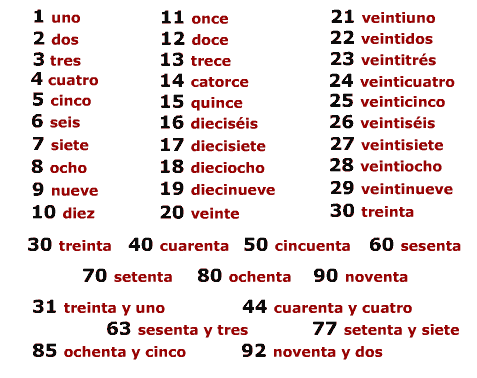Spanish numbers from 1 to 1000 are not too difficult to learn. And just like in English, there are still some exceptions in the way to form numbers. Their construction still follows some rules which allow you to learn them easily. Here in this article, we will show you how to say numbers in Spanish, how to count to 10, how to count to 100, and when to use cardinal numbers. Let’s find out!
Numbers in Spanish 1 - 100
Spanish numbers 0 - 9
- 0 - cero
- 1 - uno
- 2 - dos
- 3 - tres
- 4 - cuatro
- 5 - cinco
- 6 - seis
- 7 - siete
- 8 - ocho
- 9 - nueve
Spanish numbers 10 - 20
- 10 - diez
- 11 – once
- 12 – doce
- 13 – trece
- 14 – catorce
- 15 – quince
- 16 – dieciséis
- 17 – diecisiete
- 18 – dieciocho
- 19 – diecinueve
- 20 – veinte
Twenties in Spanish - Numbers in Spanish from 21 to 29
Formula: veinti + number from 1 to 9 (no space in between)
- 21 - veintiuno
- 22 - veintidós
- 23 - veintitrés
- 24 - veinticuatro
- 25 - veinticinco
- 26 - veintiséis
- 27 - veintisiete
- 28 - veintiocho
- 29 - veintinueve
The multiples of 10 – Numbers in Spanish 10 – 100
- 10 - diez
- 20 - veinte
- 30 - treinta
- 40 - cuarenta
- 50 - cincuenta
- 60 - sesenta
- 70 - setenta
- 80 - ochenta
- 90 - noventa
- 100 - cien/ciento
Numbers in Spanish from 31 to 99
Formula: a multiple of 10 + y + a number from 1 to 9
- 32 - treinta y dos
- 41 - cuarenta y uno
- 56 - cincuenta y seis
- 99 - noventa y nueve

Numbers in Spanish 1 - 100
Numbers in Spanish 100 -1000
Numbers from 100 to 199
Formula: uno + a number from 1 to 99
- 101 - ciento uno
- 129 - ciento veintinueve
- 195 - ciento noventa y cinco
The multiples of 100
To count numbers from 200 to 999, you need to learn the multiples of 100 first.
- 200 - doscientos
- 300 - trescientos
- 400 - cuatrocientos
- 500 - quinientos
- 600 - seiscientos
- 700 - setecientos
- 800 - ochocientos
- 900 - novecientos
Numbers from 201 to 999
Formula: the multiples of 100 + a number from 1 to 99
- 201 - doscientos uno
- 220 - doscientos veinte
- 238 - doscientos treinta y ocho
Spanish numbers from one thousand to 1 million
- 1,000 - mil
- 1,001 = mil uno (not “mil y uno”)
- 1,500 = mil quinientos
- 1,686 = mil seiscientos ochenta y seis
- 2,000 – dos mil
- 2,001 = dos mil uno
- 10,000 – diez mil
- 20,000 - veinte mil
- 33,000 - treinta y tres mil
- 100,000 - cien mil
- 483,382 - cuatrocientos ochenta y tres mil trescientos ochenta y dos
- 1,000,000 - un millón
- 3,000,000 - tres millones
- 6,492,000 - seis millones cuatrocientos noventa y dos mil
When to use cardinal numbers in Spanish?
1. To tell time
Examples:
Son las ocho - It is eight o'clock
Es la una de la tarde - It's one in the afternoon
See: Telling time in Spanish.
2. To talk about dates, years, and centuries
When talking about dates, you need to use cardinal numbers rathers than ordinal numbers in Spanish.
Examples:
Hoy es el diecinueve de mayo - Today is May 19th
El primero de enero es mi cumpleaños - January 1st is my birthday
¿Cuáles son tus planes para dos mil veinte (2020)? - What are your plans for 2020?
See Spanish days of the week and months of the year.
3. To talk about age, weights, prices, measurements, and amounts
Examples:
Yo tengo veintitrés años - I am twenty-three years old
Mi hermana tiene treinta y dos años - My sister is thirty-two years old
Un cocodrilo puede pesar hasta mil cuarenta y tres (1,043) kilogramos - A crocodile can weigh up to 1,043 kg.
4. To count and to talk about calculations
Dos más tres son cinco - Two plus three is five
Hay ciento noventa y cinco (195) países en el mundo - There are 195 countries in the world.
Now that you know how to count or how to say all numbers in Spanish and how to use them in different situations. If you have any questions, simply leave a comment below.
Hope it helps!
